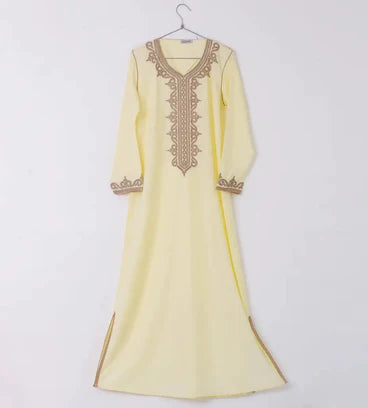The Kaftan is an elegant garment from ancient Mesopotamia that has become an internationally popular trend, symbolizing timeless elegance and comfort. But the question is: How to make a kaftan dress? At New Arabia, your go-to shop for beautiful yet distinctive apparel, we will help you set your creative side free and stitch a unique Kaftan Dress of your design!
Before Beginning: Select Fabric and Design Options
The initial step to “How to make a kaftan dress?” is selecting its fabric and a particular design. Find the versatility of the kaftan and find all its various uses - from beach vacationing maxis to chic midis for night-out ensembles - there are endless fabric and design choices that await.
Fabric Selection
There are different fabric choices suited to climate and occasion, from lightweight cotton, linen, rayon and silk choices for warmer climates to luxurious satin velvet brocade materials that add glamour. Get playful by mixing printed fabric patterns, textures and embellishments together for a unique kaftan creation!
Design Variations
There are various kaftan designs, from the traditional loose silhouette with wide sleeves and floor-length hem to more tailored options such as fitted kaftans with cinched waists and shorter-length hemlines. Layer your garment for visual interest or boost its beauty further through embroidery, beadwork or lace trimmings - there are so many possibilities when it comes to creating the ideal Kaftan look!
Gather Your Supplies: Essential Items Needed for Kaftan Making
Before making a kaftan dress, ensure you have all of the supplies ready. From your sewing machine and basic tools to fabric patterns and inspiration sources - get everything together that will bring your vision to fruition!
- Create an Essential Supplies List: Come up with your fundamental inventory, consisting of items like a sewing machine, thread, pins, needles, scissors, a measuring tape and an iron.
- Fabric Selection: Before selecting fabric for any design project, ensure there is enough available allowing for seam allowances and any potential additional fabric needs.
- Pattern (Optional): Consider using an established kaftan pattern if you are new or need guidance when creating one of several different kaftan styles.
- Marking Tools: These marking tools, like tailor's chalk or fabric pens, help the fabric cutter mark it during cutting and sewing operations.
- Find Inspiration: Check out online tutorials, magazines or Pinterest boards as sources of creativity-inducing and design ideation inspiration to fuel and expand upon your design ideas and improve them further.
Crafting Your Own Kaftan Dress: A Step-by-Step Guide With New Arabian Patterns
1. Prepare Your Pattern
Whether using an already available pattern or designing one from scratch, make sure that the instructions for either method are carefully adhered to. When drawing up your design from scratch, take careful measurements for the body and sleeves as well as seam allowances before drawing a basic rectangle shape for both parts.
2. Cut Fabric
To cut the fabric accurately and safely, lay pattern pieces out carefully onto it, pin them in place, and cut them with care, leaving extra fabric for seam allowances.
3. Sew Shoulders
By Hand Semble the shoulder seams right sides together and press them open when sewing them with right sides together.
4. Secure Sleeves (Optional)
If using sleeves, sew them to your bodice with matching seams and notches before pressing all seams open.
5. Sew Side Seams
With right sides together and keeping seam allowances open if using sleeves, sew the side seams from hem to armpit with right sides together and right sides out, leaving an opening for armholes if applicable. Press open seam allowances when finished sewing the side seams.
6. Complete the Hemline and Neckline
According to your design, finish the neckline and hem with either a simple rolled hem, bias binding or facing for an uncluttered appearance.
7. Add Embellishments as Needed (Optional)
Play around with embroidery, rickrack, lace, buttons or any other decorative elements to customize and personalize your kaftan.
8. Press and Admire
Once sewing and embellishments have been added to the kaftan, give it one last press to ensure crisp seams and an attractive aesthetic.
Additional Tips for Success
- For beginners just starting to sew, opt for an effortless design featuring minimal seams and embellishments.
- Practice on Scrap Fabric Before Your Final Project incepe
- Don't Be Afraid of Adjustments! Kaftans' adaptable nature allows for length, width and neckline adjustments that suit individual preferences.
- To guarantee professional results when sewing the seams flat after each step is finished.
- At all costs, have fun! Most important of all, don't take yourself too seriously.
Once the basic kaftan has been mastered, advanced techniques should also be learned such as adding pockets or slits or even dyeing or painting for an individual look.
New Arabia Celebrates Your Creativity
At New Arabia, we make it easier for you to express both your individual style and cultural heritage through clothing creation. No matter your experience or skill level in sewing, New Arabia provides fabrics, tools and inspiration so that your dream kaftan becomes a reality!
After learning How to make a kaftan dress remind yourself one thing sewing is not simply about creating something tangible - enjoy every step along your journey and embrace every learning opportunity to produce masterpieces to wear with pride!



